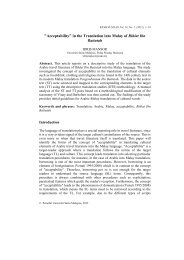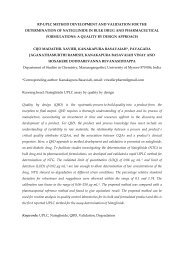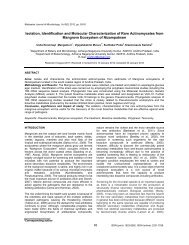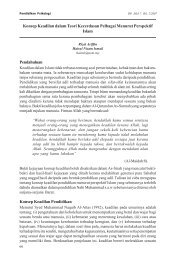45 Optimum conditions for uricase enzyme production by Gliomastix ...
45 Optimum conditions for uricase enzyme production by Gliomastix ...
45 Optimum conditions for uricase enzyme production by Gliomastix ...
Create successful ePaper yourself
Turn your PDF publications into a flip-book with our unique Google optimized e-Paper software.
Malaysian Journal of Microbiology, Vol 5(1) 2009, pp. <strong>45</strong>-50<br />
<strong>Optimum</strong> <strong>conditions</strong> <strong>for</strong> <strong>uricase</strong> <strong>enzyme</strong> <strong>production</strong> <strong>by</strong> <strong>Gliomastix</strong> gueg<br />
Atalla M. M., 1 Farag, M. M., 2 Eman, R. H., 1 Abd-El-Lataif, M. S. 2 and Nehad E. A. 1<br />
1 Department of Microbial Chemistry Products, National Research Center (NRC), Dokki and 2 Depatment of Biochemistry,<br />
Faculty of Agriculture, Cairo University, Giza, Egypt.<br />
E-mail: erhamed@yahoo.com<br />
Received 2 July 2008; received in revised <strong>for</strong>m 26 February 2009; accepted 26 February 2009<br />
_______________________________________________________________________________________________<br />
ABSTRACT<br />
Nineteen strains of microorganisms were screened <strong>for</strong> <strong>uricase</strong> <strong>production</strong>. <strong>Gliomastix</strong> gueg was recognized to produce<br />
high levels of the <strong>enzyme</strong>. The optimum fermentation <strong>conditions</strong> <strong>for</strong> <strong>uricase</strong> <strong>production</strong> <strong>by</strong> <strong>Gliomastix</strong> gueg were<br />
examined. Results showed that uric acid medium was the most favorable one, the optimum temperature was at 30ºC,<br />
and incubation period required <strong>for</strong> maximum <strong>production</strong> was 8 days with aeration level at 150 rpm and at pH 8.0.<br />
Sucrose proved to be the best carbon source, uric acid was found to be the best nitrogen source. Both, dipotassium<br />
hydrogen phosphate and ferrous chloride as well as some vitamins gave the highest amount of <strong>uricase</strong> <strong>by</strong> <strong>Gliomastix</strong><br />
gueg.<br />
Keywords: <strong>Gliomastix</strong> gueg, <strong>uricase</strong> <strong>production</strong>, physiological <strong>conditions</strong><br />
_______________________________________________________________________________________________<br />
INTRODUCTION<br />
Urate oxidase or <strong>uricase</strong> (urate: oxygen oxidoreductase,<br />
EC 1.7.3.3) is an <strong>enzyme</strong> that catalyse the oxidation of<br />
uric acid to allantoin and plays an important role in purine<br />
metabolism (Wu et al., 1994). This <strong>enzyme</strong> is widely<br />
present in most vertebrates but is absent in humans<br />
(Schiavon et al., 2000). It was first found in bovine kidney.<br />
Various natural sources such as bacteria (Mansour et al.,<br />
1996), fungi (Farley and Santosa, 2002) and eukaryotic<br />
cells (Montalbini et al., 1997) have also been found to be<br />
<strong>uricase</strong> producers. The first important application<br />
discovered <strong>for</strong> <strong>uricase</strong> was in clinical biochemistry as a<br />
diagnostic reagent <strong>for</strong> measurement of uric acid in blood<br />
and other biological fluids (Adamek et al., 1989). Higher<br />
primates (apes and humans) lack functional <strong>uricase</strong> and<br />
excrete uric acid as the end product of purine degradation<br />
(Friedman et al., 1985; Yeldandi et al., 1990). In some<br />
individuals, uric acid precipitates, leading to gout<br />
symptoms. Gout treatment generally includes allopurinol,<br />
which is a potent competitive inhibitor of xanthine<br />
dehydrogenase, an <strong>enzyme</strong> which catalyses the<br />
conversion of hypoxanthine to xanthine and xanthine to<br />
uric acid. However, in the case of gout associated with<br />
renal complications, direct injection of urate oxidase<br />
allows much more rapid resorption of urate<br />
nephrolithiases. Such injections are done to prevent or<br />
treat hyperuricemia disorders that may occur during<br />
chemotherapy.<br />
Gout is a painful disorder, characterized <strong>by</strong> uricemia,<br />
recurrent attacks of acute arthritis, deposition of sodium<br />
urate in and around joints, and in many cases, <strong>for</strong>mation<br />
of uric acid calculi (Lee et al., 1988).<br />
*Corresponding author<br />
<strong>45</strong><br />
Uricase was originally isolated from mammalian<br />
organisms. Recently interest was concentrated on<br />
microbial preparations from various fungi, yeast and<br />
bacteria. The microbial <strong>enzyme</strong> is inducible and there<strong>for</strong>e,<br />
the presence of uric acid or some other inducer in the<br />
medium is necessary <strong>for</strong> <strong>enzyme</strong> <strong>production</strong> (Adamek et<br />
al., 1989). Although several microbial sources of <strong>uricase</strong><br />
have been proposed <strong>for</strong> this clinical indication, only one<br />
has actually been used commercially under the trade<br />
mark of uricozyme and is isolated and purified from<br />
Aspergillus flavus .<br />
In various microorganisms <strong>uricase</strong> synthesis is<br />
regulated <strong>by</strong> components of the growth medium and the<br />
ability to degrade uric acid and to use it <strong>for</strong> growth is an<br />
inducible property of these microorganisms (Vander Drift<br />
and Vogels, 1975). Moreover, it was suggested that<br />
<strong>uricase</strong> <strong>for</strong>mation might be controlled <strong>by</strong> a repression in<br />
which a metabolite derived from both the nitrogen and<br />
carbon sources may participate (Bongaerts et al., 1977).<br />
Several investigators (Yazdi et al., 2006; Lotfy, 2008 )<br />
studied the optimal temperature and pH <strong>for</strong> the <strong>production</strong><br />
of <strong>uricase</strong> <strong>by</strong> microorganisms. The effect of various<br />
carbon and nitrogen sources on the <strong>for</strong>mation of <strong>uricase</strong><br />
<strong>by</strong> microorganisms was studied <strong>by</strong> several authors (Azab<br />
et al., 2005; Zhou et al., 2005; Yazdi et al., 2006; Lotfy,<br />
2008).<br />
The main purpose of this research is to screen the<br />
available local fungal strains <strong>for</strong> their <strong>uricase</strong> producing<br />
ability, to select the most potent isolate and also to<br />
optimize the culture <strong>conditions</strong> <strong>for</strong> maximum <strong>uricase</strong><br />
<strong>production</strong>.
Mal. J. Microbiol. Vol 5(1) 2009, pp. <strong>45</strong>-50<br />
MATERIALS AND METHODS<br />
Organisms<br />
All strains investigated in this study were brought from the<br />
culture collection of the Department of Chemistry of<br />
Natural and Microbial Products at the National Research<br />
Center. The cultures were maintained on Czapek dox<br />
agar and stored at (5 to 6 °C).<br />
Media<br />
Three different media were used <strong>for</strong> <strong>uricase</strong> <strong>production</strong>.<br />
Yeast extract sucrose medium: Sucrose 150.0 g; yeast<br />
extract 20.0 g. (Davis et al., 1966). Czapek- Dox- medium:<br />
NaNO3 2.0 g; K2HPO4 1.0 g; KCl 0.5 g; MgSO4 0.5 g;<br />
FeSO4.7H2O 0.01 g and sucrose 20.0 g. (Huang and Ling,<br />
1973). Uric acid medium: uric acid 1.0 g; K2HPO4 1.0 g;<br />
MgSO4 0.5 g; NaCl 0.5 g; FeSO4 0.01 g and sucrose 20.0<br />
g. (Abdel Fattah and Abo hamed, 2002). Ingredient of<br />
each medium was dissolved in 1 liter distilled water and<br />
pH was adjusted to 6.5-7.0.<br />
Fermentation <strong>conditions</strong><br />
Fifty mL aliquots of fermentation medium were dispensed<br />
in 250 mL Erlenmeyer conical flasks, inoculated with two<br />
discs (10 mm in diameter) from 7-day old cultures. The<br />
inoculated flasks were incubated on a rotatory incubator<br />
shaker at 150 rpm <strong>for</strong> 8 days at 30 °C after which the<br />
mycelium of each isolate was collected <strong>by</strong> centrifugation<br />
at 5000 to 6000 rpm <strong>for</strong> 15 min at 4 °C. The cell free<br />
supernatant was used as a crude <strong>enzyme</strong> <strong>for</strong> further<br />
determinations.<br />
Enzyme assay<br />
Uricase activity was measured according to the procedure<br />
described <strong>by</strong> Adamek et al. (1989). To 2 mL of a solution<br />
containing uric acid (10ug per ml of borate buffer 0.2 M,<br />
pH 8.5), 0.8 mL of water and 0.1 mL of crude <strong>enzyme</strong> at<br />
25 °C were added. After 10 min, 0.2 mL of 0.1 M<br />
potassium cyanide solution was added to the mixture to<br />
stop the <strong>enzyme</strong> reaction. In the reference sample, the<br />
solution of potassium cyanide was added to the mixture<br />
be<strong>for</strong>e the addition of the crude <strong>enzyme</strong>. The absorbance<br />
of both samples was measured at 293 nm. The difference<br />
between absorbance of the sample and reference is<br />
equivalent to the decrease in uric acid during the <strong>enzyme</strong><br />
reaction. One unit of <strong>uricase</strong> <strong>enzyme</strong> was equal to the<br />
amount of <strong>enzyme</strong> which converts 1 µmol of uric acid to<br />
allantoin per min at 30 °C.<br />
Factors affecting <strong>uricase</strong> <strong>production</strong><br />
Carbon sources<br />
Sucrose was omitted from uric acid fermentation media<br />
and replaced <strong>by</strong> 1% of each glucose, fructose, lactose,<br />
starch, cellulose and glycerol.<br />
46<br />
Nitrogen sources<br />
Uric acid was omitted from uric acid fermentation medium<br />
and supplemented <strong>by</strong> 0.5% of NaNO3, KNO3, (NH4)2SO4,<br />
NH4Cl, peptone and casein as a sole sources of nitrogen.<br />
Phosphate sources<br />
Different sources of phosphate (KH2PO4, Na2HPO4 and<br />
NaH2PO4) have been added to the fermentation medium<br />
at a concentration equimolar to the concentration of the<br />
basal phosphate source (K2HPO4).<br />
Elements<br />
Different elements such as Ca 2+ (CaCl2), CO 2+ (COCl2),<br />
Mn 2+ (MnSO4), Mg 2+ (MgSO4), Fe 3+ (FeCl3), PO4 3-<br />
(Na2HPO4), CN -1 (Na CN), I3 (Iodine) and Hg +2 (HgCl2)<br />
have been added to the culture medium at a concentration<br />
equimolar to the concentration of the basal element of the<br />
medium.<br />
Vitamins<br />
Some vitamins such as riboflavin, nicotinic acid, folic acid<br />
and ascorbic acid were added to the fungal culture at a<br />
concentration 1.0 g/L of each vitamin and sterilized <strong>by</strong><br />
filtration.<br />
Amino acid<br />
Addition of the individual amino acid at 1.0 g/L of cysteine,<br />
cystine, arginine, glycine and tryptophane to the fungal<br />
culture. The pH was adjusted to 8.0.<br />
RESULTS AND DISCUSSION<br />
Selection of fungal strains <strong>for</strong> <strong>uricase</strong> <strong>production</strong><br />
The aim of this experiment was to select the fungal strain<br />
which able to produce the highest amount of <strong>uricase</strong>. The<br />
nineteen fungal strains were inoculated in yeast extract<br />
sucrose medium at pH 6.5 and incubated <strong>for</strong> 7 days in an<br />
incubator shaker at 150 rpm and 30 °C.<br />
Results in Table 1 show that all tested strains<br />
produced <strong>uricase</strong> <strong>enzyme</strong>. The two strains belonging to<br />
<strong>Gliomastix</strong> gueg (NRC1A) and Gliocladium virens<br />
(NRC24SH) proved to have higher <strong>uricase</strong> producing<br />
potential 275.98 and 233.90 U/mL respectively, followed<br />
<strong>by</strong> Alternaria solani (NRC10) (177.67 U/mL) and<br />
Aspergillus niger (NRC4) (164.98 U/mL). Chalaropsis sp.<br />
(NRC4A) produced less amount of <strong>uricase</strong> (17.69 U/mL).<br />
From the obtained results <strong>Gliomastix</strong> gueg (NRC1A) was<br />
selected <strong>for</strong> the subsequent experiments.<br />
Fermentation medium<br />
Two disks of G. gueg (NRC1A) were inoculated in 250<br />
conical flasks containing 50 mL of each of the following<br />
medium: uric acid, Czapek dox and yeast extract sucrose.
Mal. J. Microbiol. Vol 5(1) 2009, pp. <strong>45</strong>-50<br />
The inoculated flasks were incubated at 30 °C on an<br />
incubator shaker (150 rpm) <strong>for</strong> 8 days at pH 8.0.<br />
The results in Table 2 showed that uric acid medium<br />
was the most favorable medium <strong>for</strong> <strong>uricase</strong> <strong>production</strong><br />
(1343.99 U/mL), while Czapek dox medium (535.15 U/mL)<br />
was the lowest one. This may be due to that several fungi<br />
can utilize uric acid as a sole source of nitrogen or to<br />
satisfy their requirements of nitrogen and carbon. These<br />
results were in confirmity with what obtained <strong>by</strong> Lookwood<br />
and Garrison (1968).<br />
Table 1: Uricase <strong>enzyme</strong> activity <strong>by</strong> different fungal<br />
strains<br />
Fungal strains Uricase<br />
activity<br />
Acremonium zonatum (NRC12P)<br />
Alternaria solani (NRC4P)<br />
A. solani (NRC10)<br />
A. teneus (NRC13P)<br />
Aspergillus awamori (NRC32)<br />
A. candidus (NRC15)<br />
A. flavus (NRC16)<br />
A. flavus (NRC17)<br />
A. niger (NRC4)<br />
Blastomyces cost (NRC16P)<br />
B. dermatitides (NRC1)<br />
Chalaropsis sp. (NRC4A)<br />
Cladosporium macrocarpum (NRC9A)<br />
Gliocladium virens (NRC24SH)<br />
<strong>Gliomastix</strong> gueg (NRC1A)<br />
Gonatorrhodiella parasitica (NRC40)<br />
Martensiomyces pterosporus (NRC27)<br />
Scopulariopsis candida (NRC7A)<br />
S. fusca (NRC6A)<br />
(U/mL)<br />
39.<strong>45</strong><br />
57.59<br />
177.67<br />
<strong>45</strong>.26<br />
53.86<br />
126.88<br />
71.39<br />
131.60<br />
164.98<br />
46.71<br />
<strong>45</strong>.98<br />
17.69<br />
88.06<br />
233.90<br />
275.98<br />
131.89<br />
57.00<br />
40.18<br />
30.82<br />
Table 2: Effect of different fermentation media on <strong>uricase</strong><br />
<strong>production</strong> <strong>by</strong> <strong>Gliomastix</strong> gueg (NRC1A)<br />
Fermentation media Uricase activity (U/mL)<br />
Uric acid<br />
Czapek dox<br />
Yeast extract sucrose<br />
Temperature<br />
1343.99<br />
535.15<br />
876.74<br />
An experiment was designed to determine the optimum<br />
temperature <strong>for</strong> fungal growth to produce high quantity of<br />
<strong>uricase</strong> <strong>enzyme</strong>. Uric acid medium was inoculated with<br />
the fungal strain, maintained on an incubator shaker at<br />
different degrees of temperature (26, 28, 30, 32, and 35<br />
°C) <strong>for</strong> 8 days at pH 6.5. Results given in Figure 1 show<br />
that <strong>uricase</strong> <strong>production</strong> increased as incubation<br />
temperature increased until reached maximum (141.76<br />
U/mL) at 30 °C and then decreased. These results were in<br />
agreement with those of Ammar et al. (1988), Tohamy<br />
and Shindia (2001), Abd El Fattah and Abo Hamed (2002)<br />
and Yazdi et al. (2006) who found that the optimum<br />
temperature <strong>for</strong> <strong>uricase</strong> <strong>production</strong> was 30 °C.<br />
47<br />
Temperature (°C)<br />
Figure 1: Effect of Different temperatures on <strong>uricase</strong><br />
<strong>enzyme</strong> <strong>production</strong><br />
pH<br />
The purpose of this experiment was to determine the<br />
optimum pH-value of fermentation medium suitable <strong>for</strong><br />
<strong>uricase</strong> <strong>production</strong>. <strong>Gliomastix</strong> gueg (NRC1A) was<br />
inoculated in fermentation medium adjusted at different<br />
pH values (5.0, 5.5, 6.0, 6.5, 7.0, 7.5, 8.0, 8.5 and 9.0). All<br />
complementary methods were adopted as mentioned<br />
be<strong>for</strong>e. Results presented in Figure 2 show that the<br />
optimal pH <strong>for</strong> <strong>uricase</strong> <strong>production</strong> (521.22 U/mL) <strong>by</strong> G.<br />
gueg (NRC1A) was pH 8.0. More or less than this point<br />
decreased <strong>uricase</strong> <strong>production</strong>. These results coincided<br />
with those of Greene and Mitchell (1957) who produced<br />
<strong>uricase</strong> from Neurospora crassa at pH 8.8, but they were<br />
slightly in agreement with those of Tohamy and Shindia<br />
(2002) and Yazdi et al (2006) who found that pH 6.0 was<br />
optimum <strong>for</strong> <strong>uricase</strong> <strong>production</strong> from A. flavus and Mucor<br />
hiemalis, respectively. Thapar et al (1975) showed that<br />
the highest <strong>production</strong> of <strong>uricase</strong> <strong>by</strong> A. wentii was at pH<br />
10. In this connection, the optimum pH <strong>for</strong> <strong>uricase</strong><br />
<strong>production</strong> <strong>by</strong> A. flavus S.79 was reported at pH 9.2<br />
(Ammar et al., 1988).<br />
Uricase activity (U/mL)<br />
Uricase activity (U/mL)<br />
pH<br />
Figure 2: Effect of initial pH value of the medium on<br />
<strong>uricase</strong> <strong>enzyme</strong> <strong>production</strong>
Mal. J. Microbiol. Vol 5(1) 2009, pp. <strong>45</strong>-50<br />
Aeration level<br />
It was economically important to examine the role of<br />
aeration level on <strong>uricase</strong> <strong>production</strong> in the fermentation<br />
medium. From the results recorded in Figure 3, it was<br />
observed that increasing aeration level was in favour of<br />
more <strong>uricase</strong> <strong>production</strong> and reached maximum (804.19<br />
U/mL) at 150 rpm, then decreased upon increasing the<br />
agitation speed (81.54 U/mL). Such finding was also<br />
obtained <strong>by</strong> Azab et al. (2005) who found that <strong>uricase</strong> was<br />
produced <strong>by</strong> Proteus vulgaris in submerged fermentation<br />
flasks on an incubator shaker at 180 rpm.<br />
Uricase activity (U/ml)<br />
900<br />
800<br />
700<br />
600<br />
500<br />
400<br />
300<br />
200<br />
100<br />
0<br />
0 100 150 200 250<br />
aeration level (rpm)<br />
Figure 3: Effect of different aeration levels on <strong>uricase</strong><br />
<strong>enzyme</strong> <strong>production</strong><br />
Carbon sources<br />
This experiment was designed to select the favorable<br />
carbon source <strong>for</strong> <strong>uricase</strong> <strong>production</strong>. The results in<br />
Figure 4 show that the highest amount of <strong>uricase</strong> <strong>enzyme</strong><br />
(1133.19 U/mL) was produced in the medium containing<br />
sucrose. These results were in agreement with those of<br />
Abd El Fattah and Abo Hamed (2002) who showed that A.<br />
flavus produced the highest amount of <strong>uricase</strong> in the<br />
medium containing sucrose.<br />
Nitrogen sources<br />
The present experiment was conducted to test the<br />
suitability of different nitrogen sources <strong>for</strong> <strong>uricase</strong><br />
<strong>production</strong>. The results presented in Figure 5 show that G.<br />
gueg (NRC1A) recorded highest amount of <strong>uricase</strong><br />
(1133.19 U/mL) when the fermentation medium contained<br />
uric acid. Similar results were obtained <strong>by</strong> other workers<br />
i.e. Yazdi et al. (2006) and Abd El Fattah and Abo Hamed<br />
(2002), who produced <strong>uricase</strong> in medium containing uric<br />
acid as a sole nitrogen source.<br />
Phosphours sources<br />
The results presented in Figure 6 show that dipotassium<br />
hydrogen phosphate gave the highest amount of <strong>uricase</strong><br />
(1133.19 U/mL). It was obvious that potassium phosphate<br />
is more suitable than sodium phosphate. These results<br />
48<br />
were disagree with those of Abd El Fattah et al. (2005)<br />
who found that KH2PO4 gave the highest amount of<br />
<strong>uricase</strong> as compared with K2HPO4. Hydrogen ion plays an<br />
important role <strong>for</strong> the acidic range balance.<br />
Uricase activity (U/ml)<br />
Uricase activity (U/ml)<br />
1200<br />
1000<br />
800<br />
600<br />
400<br />
200<br />
0<br />
1200<br />
1000<br />
800<br />
600<br />
400<br />
200<br />
Glucose<br />
0<br />
sodium nitrate<br />
Fructose<br />
potassium nitrate<br />
Lactose<br />
peptone<br />
Starch<br />
casein<br />
Sucrose<br />
Carbon sources<br />
uric acid<br />
Cellulose<br />
ammonium sulphate<br />
Glycerol<br />
Figure 4: Effect of different carbon sources on <strong>uricase</strong><br />
<strong>enzyme</strong> <strong>production</strong><br />
ammonium chloride<br />
Nitrogen sources<br />
Figure 5: Effect of different nitrogen sources on <strong>uricase</strong><br />
<strong>enzyme</strong> <strong>production</strong><br />
Incubation period<br />
The goal of this experiment was to select the optimum<br />
incubation period <strong>for</strong> <strong>uricase</strong> <strong>production</strong> <strong>by</strong> G. gueg<br />
(NRC1A) when grown on uric acid medium at 30 °C under<br />
shaken <strong>conditions</strong> <strong>for</strong> different periods of time. Results in<br />
Table 3 indicated that 8 days incubation was optimum <strong>for</strong><br />
<strong>uricase</strong> <strong>production</strong> <strong>by</strong> G. gueg (NRC1A). These results<br />
disagree with those of Abd El Fattah and Abo Hamed<br />
(2002) who produced <strong>uricase</strong> from A. flavus, Aspergillus<br />
terreus after 4 days incubation and from Trichoderma sp.<br />
after 6 days. Yukiko et al. (1976) produced maximum<br />
<strong>uricase</strong> <strong>by</strong> Hyphomyces after 5 days incubation.
Mal. J. Microbiol. Vol 5(1) 2009, pp. <strong>45</strong>-50<br />
Uricase activity (U/ml)<br />
1200<br />
1000<br />
800<br />
600<br />
400<br />
200<br />
0<br />
K2HPO4 KH2PO4 Na2HPO4 NaH2PO4<br />
Phosphorus sources<br />
Figure 6: Effect of phosphorus sources on <strong>uricase</strong><br />
<strong>enzyme</strong> <strong>production</strong><br />
Table 3: Effect of incubation period on <strong>uricase</strong> <strong>enzyme</strong><br />
<strong>production</strong> <strong>by</strong> G. gueg (NRC1A)<br />
Incubation Uricase activity<br />
period (days) (U/mL)<br />
2 85.89<br />
4 53.97<br />
6 64.12<br />
8 1343.99<br />
10 558.95<br />
12 239.71<br />
14 188.92<br />
16 17.69<br />
Elements<br />
It is clear from Figure 7 that ferrous chloride gave the<br />
highest amount of <strong>uricase</strong> (1574.72 U/mL). On the other<br />
hand, sodium cyanide gave the less amount of <strong>uricase</strong><br />
(275.80 U/mL).<br />
Vitamins<br />
Data presented in Figure 8 show that folic acid and<br />
ascorbic acid had a high stimulatory effect on <strong>uricase</strong><br />
<strong>production</strong> <strong>by</strong> the experimental organism (1180.02 and<br />
1169.87 U/mL), respectively. Also, nicotinic acid and<br />
riboflavin appeared to stimulate <strong>uricase</strong> <strong>production</strong> but at<br />
a lesser extent (1053.78 and 1040.71 U/mL, respectively).<br />
Such findings were obtained <strong>by</strong> Abd El Fattah and Abo<br />
Hamed (2002) who found that the <strong>production</strong> of <strong>uricase</strong><br />
was hardly affected <strong>by</strong> the incorporation of most studied<br />
vitamins irrespective of the fungus. However, the addition<br />
of vitamin C, molasses and vitamin B12 slightly stimulated<br />
this process in A. terreus, A. flavus and Trichoderma sp.,<br />
respectively. They also demonstrated that addition of<br />
nicotinic acid, folic acid and riboflavin exhibited various<br />
inhibitory effects against <strong>uricase</strong> <strong>production</strong>.<br />
Amino acids<br />
It is clear from the results presented in Figure 9 that the<br />
presence of cystine in the medium gave the highest<br />
49<br />
amount of <strong>uricase</strong> (1024.76 U/mL) followed <strong>by</strong> glycine<br />
(1011.69 U/mL). On the other hand tryptophane gave the<br />
lowest amount of <strong>uricase</strong> (468.98 U/mL).<br />
Uricase activity (U/ml)<br />
1600<br />
1400<br />
1200<br />
1000<br />
800<br />
600<br />
400<br />
200<br />
0<br />
Control<br />
Calcium chloride<br />
Cobalt chloride<br />
Ferrous chloride<br />
Mercuric chloride<br />
Manganous sulphate<br />
Magnisem Sulphate<br />
Iodine<br />
Sodium cyanide<br />
Elements<br />
Figure 7: Effect of some elements on <strong>uricase</strong> <strong>enzyme</strong><br />
<strong>production</strong><br />
Uricase activity (U/ml)<br />
Uricase activity (U/ml)<br />
1200<br />
1150<br />
1100<br />
1050<br />
1000<br />
950<br />
1200<br />
1000<br />
800<br />
600<br />
400<br />
200<br />
Control<br />
0<br />
Control<br />
Riboflavin<br />
Cysteine<br />
Folic acid<br />
Nicotinic acid<br />
Vitamins<br />
Cystine<br />
Arginine<br />
Ascorbic acid<br />
Figure 8: Effect of different vitamins on <strong>uricase</strong> <strong>enzyme</strong><br />
<strong>production</strong><br />
Glycine<br />
Tryptophane<br />
Amino acids<br />
Figure 9: Effect of different amino acids on <strong>uricase</strong><br />
<strong>enzyme</strong> <strong>production</strong>
Mal. J. Microbiol. Vol 5(1) 2009, pp. <strong>45</strong>-50<br />
REFERENCES<br />
Abd El Fattah, M. G. and Abo-Hamed, N. A. (2002).<br />
Bioconversion of poultry waste I – Factors influencing<br />
the assay and productivity of crude <strong>uricase</strong> <strong>by</strong> three<br />
uricolytic filamentous fungi. Acta Microbiologica and<br />
Immunologica Hungarica 49, 4<strong>45</strong>-<strong>45</strong>4.<br />
Abd El Fattah, Y. R., Saeed, H. M., Gohar, Y. M. and El-<br />
Baz, M. A. (2005). Improved <strong>production</strong> of<br />
Pseudomonas aeruginosa <strong>uricase</strong> <strong>by</strong> optimization of<br />
process parameters through statistical experimental<br />
designs. Process Biochemistry 40, 1707-1714.<br />
Adamek, V., Kralova, B., Suchova, M., Valentova, O.<br />
and Demnerova, K. (1989). Purification of microbial<br />
<strong>uricase</strong>. Journal of Chromatography 497, 268-275.<br />
Ammar, M. S., Elwan, S. H. and El-Desouky, E. M.<br />
(1988). Purification and some properties of <strong>uricase</strong><br />
from Aspergillus flavus S-97. Egyptian Journal of<br />
Microbiology 23, 83.<br />
Azab, E. A., Ali, M. M. and Fareed, M. F. (2005). Studies<br />
on <strong>uricase</strong> induction in certain bacteria. Egyptian<br />
Journal of Biology 7, 44-54.<br />
Bongaerts, G. P. A., Sin, L. I., Peters, J. L. J. and<br />
Vogels, D. G. (1977). Purine degradation in P<br />
seudomonas aeruginosa and Pseudomonas<br />
testosterone. Biochimica et Biophysica Acta 499,<br />
111-118.<br />
Davis, N. D., Diener, U. L. and Eldridge, D. W. (1966).<br />
Production of aflatoxins B1 and G1 <strong>by</strong> Aspergillus<br />
flavus in a semisynthetic medium. Applied<br />
Microbiology 14, 378-380.<br />
Farley, P. C. and Santosa, S. (2002). Regulation of<br />
expression of the Rhizopus oryzae <strong>uricase</strong> and<br />
urease <strong>enzyme</strong>. Canadian Journal of Microbiology<br />
48, 1104-1108.<br />
Friedman, T. B., Polanco, G. E. Appold, J. C. and<br />
Mayle, J. E. (1985). On the loss of uricolytic activity<br />
during primate evalution. I. Silencing of urate oxidase<br />
in a hominoid ancestor. Comparative Biochemistry<br />
and Physiology 81B, 653-659.<br />
Greene, R. C. and Mitchell, H. K. (1957). Uricase in –<br />
Neurospora crassa. Archives of Biochemistry and<br />
Biophysics 70, 603-613.<br />
Huang, J. C. and Ling, K. H. (1973). Isolation and<br />
identification of a toxic hydrophilic metabolite from the<br />
culture broth of Penicillium sp. 171. Journal of the<br />
Formosan Medical Association 72, 649-657.<br />
Lee, C. C., Wu, R. A., Giggs, R. G., Cook, Muzny, D. M.<br />
and Caskey, T. (1988). Generation of cDNA probes<br />
directed <strong>by</strong> amino acids sequence: cloning of urate<br />
oxidase. Science 293, 1288-1291.<br />
Lookwood, G. F. and Garrison, R. G. (1968). The<br />
possible role of uric acid in the ecology of<br />
Histoplasma capsuatum. Mycopathol. Mycol. Appl. 35,<br />
377.<br />
Lotfy, W. A. (2008). Production of thermostable <strong>uricase</strong><br />
<strong>by</strong> a novel Bacillus thermocatenulatus strain.<br />
Bioresource Technology 99, 699-702.<br />
Mansour, F. A., Nour- El- Dein, M. M., El- Fallel, A. A.<br />
and Abou-Do-Bara, M. I. M. (1996). Purification and<br />
50<br />
general properties of <strong>uricase</strong> from Streptomyces<br />
aureomonopodiales. Acta Microbiologica Polonica <strong>45</strong>,<br />
<strong>45</strong>-53.<br />
Montalbini, P., Redondo, J., Caballero, J. L., Cardenas,<br />
J. and Pineda, M. (1997). Uricase from leaves: its<br />
purificación and characterization from three different<br />
higher plants. Planta Heidelberg 202, 277-283.<br />
Schiavon, O., Caliceti, P., Ferruti, P. and Veronese, F.<br />
M. (2000). Therapeutic proteins: a comparison of<br />
chemical and biological properties of <strong>uricase</strong><br />
conjugated to linear or branched poly (ethylene<br />
glycol) and poly (Narryloylmorpholine). II Farmaco 55,<br />
264-269.<br />
Thapar, V. K., Sethi, R. P. and Rattan, S. (1975).<br />
Studies on fungal <strong>uricase</strong> extraction, purification and<br />
properties. Jers. Punijab Agric Univ. 12, 62.<br />
Tohamy, E. Y. and Shindia, A. A. (2001). Partial<br />
purification and some properties of <strong>uricase</strong> produced<br />
<strong>by</strong> strain of Aspergillus terreus. Egyption Journal of<br />
Microbiology 36, 77-87.<br />
Vander Drift, L. and Vogels, D. C. (1975). Allantoin<br />
racemase: a new <strong>enzyme</strong> from Pseudomonas<br />
species. Biochimica et Biophysica Acta 391, 240-248.<br />
Wu, X., Wakamiya, M., Vaishnav, S., Geske, R.,<br />
Montgomery, C., Jones, P., Bradley, A. and<br />
Caskey, T. (1994). Hyperuricemia and urate<br />
nephropathy in urate oxidase deficient mice.<br />
Proceedings in Natural Academy Science of USA 91,<br />
742-746.<br />
Yazdi, M. T., Zarrini, G., Mohit, E., Faramarzi, M. A.,<br />
Setayesh, N. and Mohseni, F. A. (2006). Mucor<br />
hiemalis: a new source <strong>for</strong> <strong>uricase</strong> <strong>production</strong>. World<br />
Journal of Microbiology and Biotechnology 22, 325-<br />
330.<br />
Yeldandi, A. V., Wang, X., Alvares, K., Kumar, S., Rao,<br />
M. S. and Reddy, J. K. (1990). Human urate oxidase<br />
gene: colning and partial sequence analysis reveal a<br />
stop codon within the fifth exon. Biochemical and<br />
Biophysical Research Communications 171, 641-6<strong>45</strong>.<br />
Yukiko, K. Yayoi, D. and Hakuy, K. (1976). The<br />
characteristics of <strong>uricase</strong> <strong>production</strong> <strong>by</strong><br />
Hyphomycetes II. The effectiveness of purines and<br />
pyrimidines as substrate. Yakugaku Zasshi, Japan 96,<br />
377.<br />
Zhou, X., Ma, X., Sun, G., Li, X. and Guo, K. (2005).<br />
Isolation of a thermostable <strong>uricase</strong> producing<br />
bacterium and study on its <strong>enzyme</strong> <strong>production</strong><br />
<strong>conditions</strong>. Process Biochemistry 40, 3749-3753.


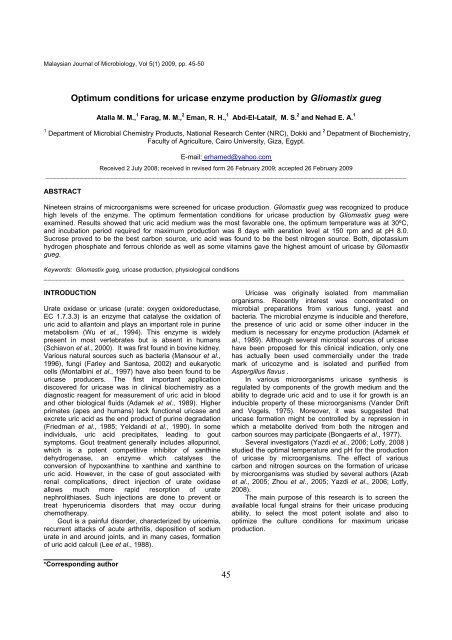

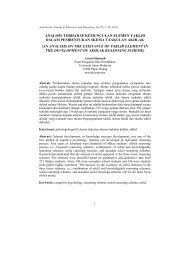
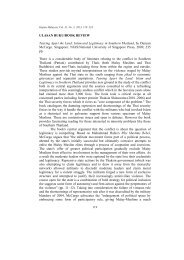

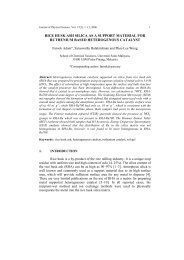

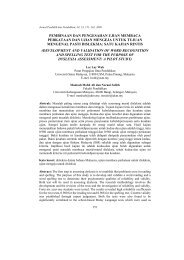
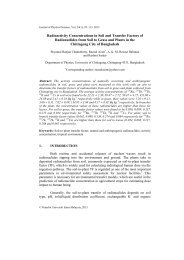
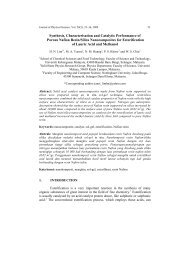

![KTT 111 – Inorganic Chemistry I [Kimia Takorganik I] - USM](https://img.yumpu.com/12405642/1/184x260/ktt-111-inorganic-chemistry-i-kimia-takorganik-i-usm.jpg?quality=85)
